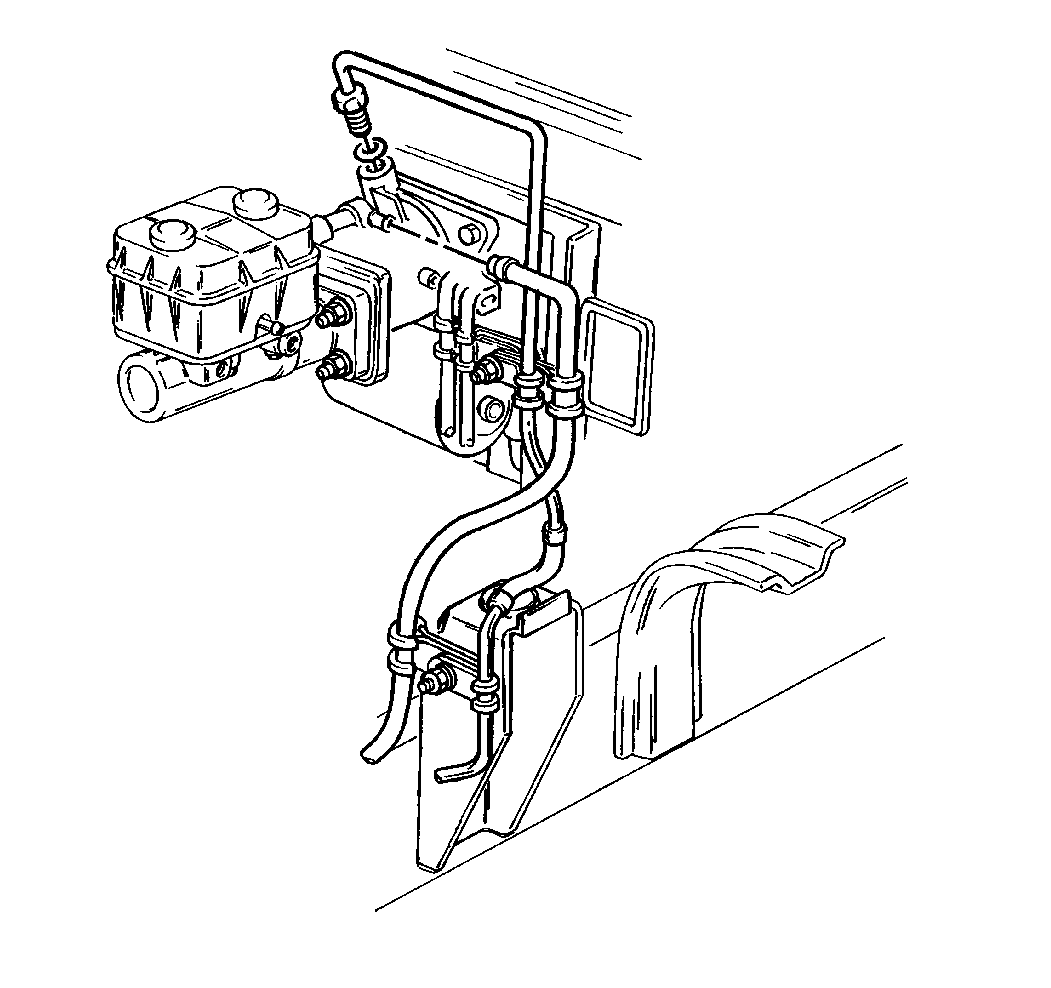Booster Assembly
The hydraulic booster applies force to the master cylinder when you apply the brake pedal. Brake pedal movement controls the power steering fluid flowing through the booster head.
The power steering fluid enters the booster at the inlet port. Power steering pump fluid flows through the control valve and the seat and exits through the outlet port and the flow switch before returning to the power steering pump.
The hydraulic booster cylinder rod attaches to a piston that contains the control valve seat. The assembly moves when you apply pressure to the brake pedal. As the control valve moves closer to the control valve seat in the piston, fluid flow is restricted and the pressure builds on one side of the piston. The pressure overcomes the return spring and moves the piston to a balanced position. The piston is balanced when the pressure on each side of the return spring equals the pressure of the hydraulic fluid flowing through the control valve and the seat. The piston pushes the cylinder rod and applies pressure to the master cylinder as the piston moves.
A relief valve inside the booster head limits the pressure to 4 826 kPa (700 psi). The limiting of the pressure in the booster head limits the brake line pressure at the master cylinder to 13 455 kPa (1950 psi). The pressure level provides firm braking without damaging the brake pipes or the hoses. The relief valve allows fluid to bypass the piston when actuated. Fluid constantly flows through the booster head when the engine is running.
Power Steering Pump
The power steering pump is a belt or a gear driven vane-type pump that sends fluid to the booster head and the power steering system. A fluid reservoir mounts to the pump. Some vehicles have an additional reservoir remotely mounted on the radiator front support.
The power steering pump provides a steady flow of fluid to the booster head. If the power steering pump stops working, an electric pump activates in order to take the place of the power steering pump.
Electrohydraulic Pump
The Electrohydraulic (EH) pump is used as a backup to the power steering pump. The EH pump comes on when the fluid stops flowing through the booster head. The EH pump is a small hydraulic pump that mounts to the bottom of the booster head.
The EH pump draws fluid from the low pressure side of the booster head piston. The EH pump delivers fluid to the high pressure side. The normal output of the EH pump is 2 070-2 415 kPa (300-500 psi) which is about half that of the power steering pump.
Flow Switch
A flow switch in the booster head outlet port senses the power steering fluid flow. The flow switch controls a relay for the EH pump. A pedal switch also activates the EH pump if you apply the brake pedal when the engine is not running.
Pipes, Hoses, and Fittings

Stationary pipes and flexible hoses carry fluid throughout the hydraulic brake booster system. The stationary pipes and the flexible hoses connect the booster head to the power steering pump and the power steering gear.
Unit Repair Information
Refer to the instructions enclosed with the service repair kit for unit repair information on the Bendix® brake booster. Contact Allied Signal Truck Brake Systems at 1-800-AIR-BRAK (1-800-247-2725) for additional unit repair information.
Fluid and Fluid Handling
Notice: Hydraulic brake systems use two distinct and incompatible fluids. Power steering fluid is used in the hydraulic brake booster system. Brake fluid is used in the master cylinder and brake pipes. Use extreme care when selecting brake system fluids, or seal damage can result. Refer to General Information to select the correct fluid.
Use the correct fluids:
| • | The master cylinder and the brake system use brake fluid. |
| • | The power steering pump uses power steering fluid. |
Notice: Do not reuse brake system fluids. Do not mix power steering fluid with brake fluid. Swelling and deterioration of rubber parts can result from the fluid contamination. This can lead to reduced brake performance and the eventual loss of braking capability.
Contaminated fluids cause swelling and deterioration of the rubber parts. The swelling and deterioration of the rubber parts cause reduction of brake performance and the eventual loss of braking capability. Inspect the condition of the fluid at regular intervals. Note any unusual consistency, color and signs of contamination in the fluid.
Do not reuse brake system fluid. Always discard the used fluid.
Do not mix power steering fluids with hydraulic brake fluids. Flush the hydraulic booster system with clean power steering fluid if contamination occurs.
Perform the booster component bench service in a clean work area separate from the brake servicing area. Do not use the same containers for power steeringand hydraulic brake fluids.
Wash your hands before changing from the brake or the booster work areas.
